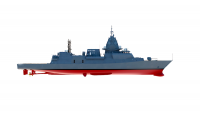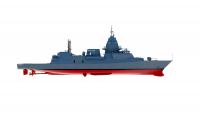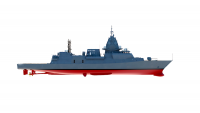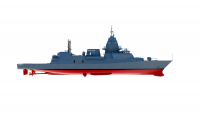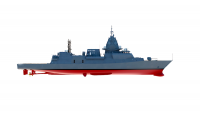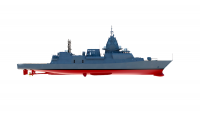Фрегати класу Hunter
Основна інформація
Головні розміри
Машина
- 1 * Rolls-Royce MT30 gas turbine
- 4 * MTU Type 20V 4000 M53B high-speed diesel generators
- 2 * electric motors
Персонал
Бойові сили та засоби
- Command & Control:
- Aegis combat system
- Saab 9LV tactical interface
- Surveillance & Weapon Sensors:
- CEA Technologies CEAFAR2 phased array radar
- CEAFAR-L L-band long range surveillance radar
- CEAFAR-S S-band multi-function radar
- CEAMOUNT fire control illuminator
- Underwater Warfare Systems
- Ultra S2150 hull-mounted sonar
- Thales Sonar 2087 towed array and variable depth sonar
- Nulka decoy launchers
- Missiles:
- 2 * 4-canister advanced anti-ship missiles
- 32 Mark 41 Vertical Launch System firing:
- RIM-66 Standard 2
- RIM-162 ESSM
- Torpedoes:
- MU90 Impact torpedoes
- Guns:
- 1 * 5-inch 54 calibre Mark 45 Mod 4 dual purpose gun
- 2 * 30mm short-range gun systems
- 2 * 20mm Phalanx CIWS
- 1 * MH-60R ‘Romeo’ Seahawk armed with:
- 2 * Mk 54 MAKO Torpedo
- 4 * AGM-114 Hellfire
The Hunter-class frigate is a future class of heavy frigates for the Royal Australian Navy (RAN) to replace the Anzac class. Construction is expected to begin in 2022, with the first of nine vessels to enter service in 2031. The Program is expected to cost AU$35 billion and a request for tender was released in March 2017 to three contenders: Navantia, Fincantieri, and BAE Systems as part of a competitive evaluation process.
The genesis of the Future Frigate Program came in 2009, when the Rudd Government’s Defence White Paper signalled Australia’s intent to «acquire a fleet of eight new Future Frigates, which will be larger than the Anzac-class vessels» with a focus on anti-submarine warfare. With an initial tender expected in 2019–20, in 2014 the Abbott Government announced that work had been brought forward, funding a preliminary design study focussed on integrating a CEAFAR Radar and Saab combat system on the hull of the Hobart-class destroyer.
Following a report by the RAND Corporation into options for Australia’s naval shipbuilding industry, the Government announced an $89 billion naval shipbuilding plan. This plan brought the schedule of the Future Frigate Program forward by three years and announced a «continuous onshore build program to commence in 2020» in South Australia. A competitive evaluation process was announced in April 2016, with Navantia, Fincantieri, and BAE Systems revealed as the contenders to design the ships.
In June 2018, the BAE Systems Type 26 was selected as the winner.
BAE Systems offered an export variant of its Type 26. The Type 26 and the smaller, cheaper Type 31 will replace the Royal Navy's Type 22 and Type 23 frigate fleets.
On 29 June 2018 the Australian Government announced that the Type 26 had been selected to fulfil the Royal Australian Navy's Future Frigate requirement. The Government also announced that the ships were to be built in Australia with Australian specific modifications and would be named the «Hunter Class» in Australian service.
The Hunter-class frigate will have a 8,800-tonne (8,700-long-ton) full load displacement and will be approximately 150 metres (492 ft 2 in) in length. The vessel will be capable of sailing in excess of 27 knots (50 km/h; 31 mph) and will have a full complement of 180 crew.
A Saab tactical interface with the Aegis combat interface will be used. The vessel will be able to carry one MH-60R ASW helicopter, and has the ability to host other Australian aircraft such as the MRH90 helicopter. The ships will be built by BAE Systems Australia at Osborne Naval Shipyard.
Кораблі9
- Коментарі
 uk
uk en
en ru
ru
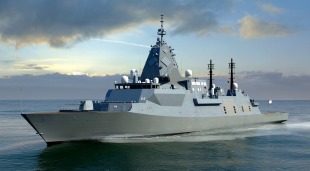

 Королівські військово-морські сили Австралії
Королівські військово-морські сили Австралії